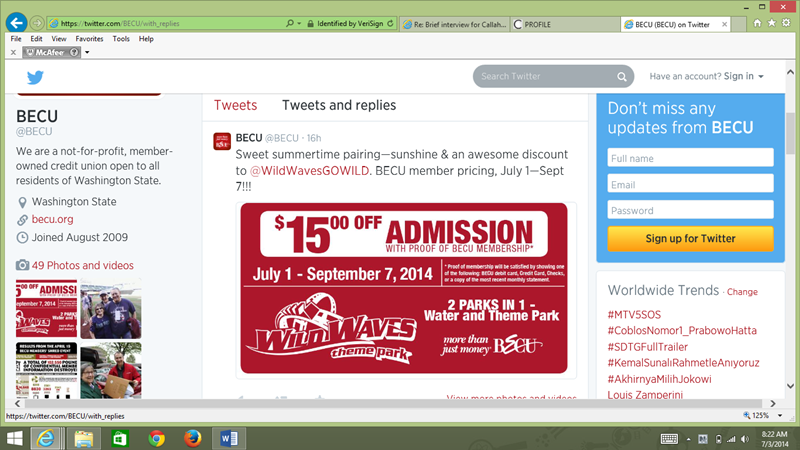Since it began engaging in social media more than five years ago, BECU ($12.6, Seattle, WA) has steadily expanded its online presence through sites such as Yelp, Facebook and, Twitter. Although its goal is to provide financial content and boost the credit union’s brand, the public nature of social media makes it a natural place for members to share positive as well as negative experiences. That’s why BECU has a 10-person, cross-functional team that monitors and resolves complaints that are posted to social media.
The team includes representatives from the marketing department, human resources, member service, information technology, and community relations, says Ross Swartwout, who monitors BECU’s Facebook and Twitter accounts via mobile alerts.


BECU has a designated team of 10 employees to monitor and resolve issues posted to its Facebook, Twitter, and Yelp accounts.
Swartwout has taken the lead with Facebook and Twitter, and a teammate handles Yelp, but that doesn’t mean the rest of the team is idle. In fact, all 10 team members contribute to the credit union’s social media outreach. The group’s members meet every two weeks to discuss new content they’d like to develop, current campaigns, and posting trends on various social media channels. Over the years the team has included both volunteers and appointees, but regardless of how they joined the team, employees work to represent the goals of their different departments. For example, human resources uses social media for recruiting purposes and community relations wants to provide educational content to engage current and potential members.
We all definitely play double-duty, says Swartwout, who is both a social media specialist and a senior designer in BECU’s marketing department.
Complaint Resolution 101
What happens when the credit union receives a complaint often depends on the type and severity of it. The credit union tries to limit its social media postings to a certain timeframe so it doesn’t become a 24/7 response center, but the mobile alerts help Swartwout respond when something severe does crop up after business hours.
For example, last night someone deposited $900 cash into an ATM and the machine jammed, Swartwout says. It was after hours so the member wasn’t able to call in and they reached out via our Facebook page. Once I saw that post, I passed it on to the ATM operations department and wrote the member a direct message to let them know someone would get in touch with them in the morning.
Quick responses help prevent posts like these from turning into larger issues.
Off-hour postings can get heated as that is when members are most likely to have a panic moment if they are having an issue and can’t get in touch with us directly, Swartwout says. They reach out through Facebook hoping for a response and want the world to know if they are upset.
To help keep its social media channels from becoming individual complaint resolution centers, BECU takes member issues offline quickly and then works to resolve them. In some cases, it posts the credit union’s general contact information or the contact information of a specific department to show it sees and is genuinely concerned with the complaints without reinforcing that the squeaky wheel gets greased.
The Right Balance
BECU tries to focus its social media presence around what is going on in the community rather than solely resolving complaints.
My goal is to maintain a 75% to 25% ratio of positive to negative commentary, says Swartwout. Since I’ve been involved I’ve seen it veer more toward the positive.
But achieving that balance isn’t always easy. For example, when the mortgage boom hit, the social media team had to pay extra attention to what was happening on social media in order to maintain its positive to negative ratio.
We had such an overwhelming hit to our mortgage department that we had to monitor [social media] closely and communicate internally to help resolve issues, Swartwout says. You’d see comments on social media from members who needed additional assistance with the process and then posts from our recruiters in HR looking for people to join our mortgage department so we could solve those issues.
What’s Next?
BECU’s social media presence has grown steadily over the past five years. It constantly analyzes information to help it evolve and refine the way it measures success.
We used to look at how many likes we had, Swartwout says. Now it is more about what kind of engagement we have with our members.
In addition to the tried-and-true channels like Facebook and Twitter, the credit union is starting to use Instagram and has done some home-centered contests via Pinterest.
We try to make sure the meat fits the bread, Swartwout says. If we’re on Pinterest, we want to do something that will resonate with that target audience.